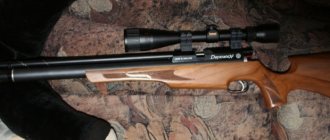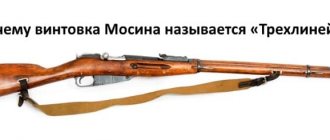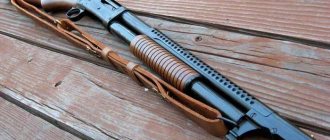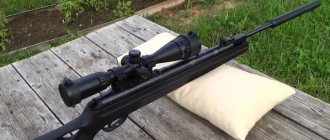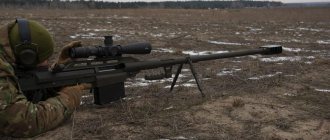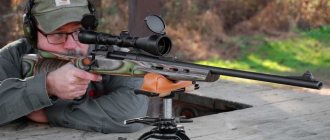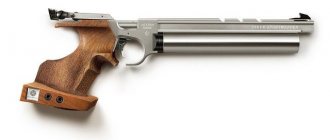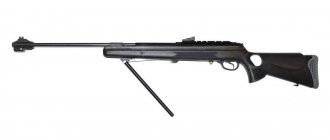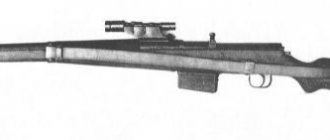Sniper rifle Walther WA 2000 (Germany)
Walther WA 2000 sniper rifle.
Walther WA 2000 sniper rifle, bipod folded over the barrel.
Walther WA 2000 sniper rifle - main components (excluding wooden stock elements).
Caliber
:.300 Win Mag, .308win (7.62x51mm NATO), 7.5x55mm Swiss
Mechanism
: semi-automatic gas operated
Length
: 905 mm
Barrel
: 650 mm
Weight without cartridges
: 6.95 kg
Magazine
: 6 rounds detachable box
The WA-2000 sniper rifle was developed by the German company Carl Walther Waffenfabrik in the early 1980s as a specialized weapon for police and counter-terrorism units. Unlike many other rifles of the same period, the WA-2000 was originally created as a specialized weapon, and had a number of interesting features. However, despite its advantages, this rifle had one significant drawback - a very high price, and therefore its production was extremely limited and did not exceed 180 copies. In the 1980s, a number of WA-2000 rifles were in service with special police units in a number of European countries (including Germany).
Structurally, the WA-2000 is a self-loading weapon, built using a gas exhaust system with locking by turning the bolt. A gas piston with a short stroke is located under the barrel. The rifle is made in a bullpup configuration, and it was possible to achieve sufficient compactness of the entire weapon with a fairly long barrel. The design is based on an aluminum frame made of two longitudinal tires located above and below the barrel and connected at the front by a special coupler and at the rear by the receiver of the weapon. The frame provides support for the elements of the weapon stock, optical sight and bipod, while protecting the cantilevered barrel from loads. The stock is adjustable to the shooter according to the length of the butt and the location of the cheek rest. The trigger mechanism is also adjustable in terms of trigger pull and trigger travel. The main cartridge chosen for the rifle is the powerful .300 Winchester Magnum cartridge, which provides a large effective firing range (up to 1000-1200 meters); in addition, the rifle can be adapted for 7.62mm NATO and 7.5mm Swiss cartridges. The cartridges are fed from single-row detachable box magazines with a capacity of 6 rounds. The folding bipod is attached to a tire located above the barrel and can be moved forward and backward on it to provide the greatest comfort when shooting. The rifle does not have conventional sighting devices; instead, there are mounts for optics. The standard optical sight is Schmidt & Bender 2.5-10X variable magnification.
Sniper rifles
Walther WA 2000. High-precision sniper rifle. (Germany)
Walther WA 2000 (Walther Automat 2000) is a German high-precision sniper rifle. It was developed by an armory in the 70s and early 80s of the 20th century by order of the German police, which required long-range, compact, high-precision weapons.
There is an opinion that, among other reasons, the impetus for this order was the failure of the operation to free hostages at the 1972 Olympics in Munich, who were captured by members of the Palestinian terrorist organization Black September, when a police sniper missed the leader of the terrorists, wounding one in the thigh from ordinary members of the terrorist group, which led to the death of 12 people (11 hostages - members of the Israeli Olympic team and 1 policeman).
The weapon was in service with anti-terrorist police units of the Federal Republic of Germany, as well as a number of other European states until 1989. Despite its merits, production of the weapon was discontinued in November 1988 due to the prohibitively high cost of its production.
Walther WA 2000. High-precision sniper rifle. (Germany)
This model of high-precision sniper weapon is a real rarity, because... Only about 180 units of the WA 2000 were produced. Currently, the collectible value of a genuine first-generation weapon starts at $40,000, and the second generation starts at $75,000.
The Walther WA 2000 is a self-loading weapon built according to the “bull dad” design, which made it possible to maintain the barrel length characteristic of sniper rifles, but reduce the overall length of the weapon. The principle of operation is a gas-operated semiautomatic device with the barrel bore being locked by turning the bolt; a gas piston with a short working stroke is located under the barrel.
The design is based on an aluminum frame made of two longitudinal tires, which are located above and below the barrel and are connected at the front by a special coupler, and at the rear - by the receiver of the weapon. The frame provides support for the elements of the weapon stock, optical sight and bipod, while protecting the cantilevered barrel from loads.
The entire structure is placed around a profiled trunk, which is installed in a rigid frame. The rear part of the frame is the rear part of the receiver. In front of the bolt mechanism, at the level of the bracket for mounting the sight, the frame is reinforced on both sides with two plates. The front part of the barrel is supported between the lower and upper frame consoles using two interconnected supports. This method ensures precise installation of the barrel, while the recoil into the shooter’s shoulder occurs in a straight line, and there is no torque.
Walther WA 2000. High-precision sniper rifle. (Germany)
As a result, the breech and bolt are located below the shooter’s cheek, which ensures the use of a long barrel in a relatively short rifle. This advantage increases the stability of the rifle when shooting and makes it very convenient when used in confined spaces.
The rifle barrel is heavy, undergoes careful processing, hangs freely, has longitudinal valleys on the outside for lightness, better cooling and to prevent the effect of harmonic vibrations, as well as a muzzle brake - a compensator on the muzzle of the barrel, which reduces recoil. Attached to the receiver with a threaded coupling. In the second generation of rifles, the muzzle brake-compensator also serves as a flash suppressor.
If it is necessary to change the caliber, the barrel is easily replaced with a barrel of a different caliber, and the bolt also needs to be replaced.
The barrel bore is locked using a longitudinally sliding bolt with a rotation, which has seven lugs, and a gas piston installed in one of the frame consoles. When all the cartridges from the magazine are used up, the bolt remains in the open position. A bolt latch is used to hold it in place. When you press it, the bolt is released and the cartridge is sent into the chamber.
The barrel bore is locked when fired by rotating the bolt 60° and placing it on all seven lugs.
For ease of debugging and adjustment, the trigger mechanism (trigger mechanism) is made in a separate block. The trigger pull force is adjustable from 1.2 to 1.4 kg, and the trigger stroke is also adjustable.
Walther WA 2000. High-precision sniper rifle. (Germany)
The trigger controls the hammer, which acts on the firing pin mounted in the bolt. The trigger and impact mechanism, disconnector, magazine and latch are located in the lower part of the rifle as a single unit, but if necessary, replacement or during disassembly can be removed separately.
The two-position non-automatic slide safety switch is located on the right side of the receiver above the trigger, the switch travel is only 2 mm.
Cartridges are fed from single-row detachable box magazines with a capacity of 6 rounds; magazines with a capacity of 10 rounds were also developed, but they never officially left Germany, that is, they were not exported.
The ammunition feeding mechanism has guides that prevent the slightest deformation of the bullet head when chambering the cartridge.
Folding bipods are of a non-standard design: their swivel unit can move along a special tire located above the barrel: the weapon seems to hang under the bipod attachment point, which has a positive effect on the convenience of aiming, the bipod folds upward. This design, combined with the short overall length of the weapon, ensures ease of shooting from almost any position.
The wooden stock, which combines a butt with thumb holes and a handle, is adjusted to the shooter's anthropometric data in terms of the length of the butt and the location of the cheek rest.
There are no open sights. The receiver cover has a mount for installing optical and night sights. The standard optical sight is Schmidt & Bender 2.5-10×56.
If transportation was necessary, the fully assembled weapon was placed in a branded weapon case.
Walther WA 2000. High-precision sniper rifle. (Germany)
Characteristics:
- Weight, kg: 6.95 kg (without cartridges and optical sight), 7.9 kg (with cartridges and optical sight);
- Length, mm: 905 mm;
- Barrel length, mm: 650 mm;
- Cartridge: .300 Winchester Magnum, .308 Winchester, 7.5×55 mm (Switzerland);
- Caliber, mm: .300; .308; 7.55;
- Operating principles: blowback;
- Initial bullet speed, m/s: 987 m/s;
- Maximum range, m: 1,000 m;
- Type of ammunition: magazine 6 rounds, magazine 5 rounds (.300);
- Sight: open - none, optical - Schmidt & Bender 2.5-10×56.
Production[edit]
The rifle was produced from 1982 [1] until November 1988. The rifle was used by some German police units, but production stopped because it was too expensive for widespread use. [1] It was never adopted by military units due to its cost and insufficient strength for field service. [3] The final retail price of a basic rifle in the 1980s ranged from $9,000 to $12,500, and the rifle's current price ranges from $40,000 for the first generation to $75,000 for the second generation. [7]
Links[edit]
- ^ B s d e g h i J k l m n Popenker, Maxim. "Walther WA 2000 sniper rifle (Germany)". world.guns.ru - Modern firearms. Retrieved May 10, 2010.
- ^ abcdefghijklmno "WA 2000 User's Guide" (PDF). Walter USA. 2004. Archived from the original (PDF) on June 17, 2004. Retrieved May 12, 2010.
- ^ ab Dougherty, Martin J. (October 16, 2012). The SAS and Elite Forces Sniper Guide: Sniping Skills from the World's Elite Forces. Globe Pequot. p. 92. ISBN 978-0-7627-8876-7. Retrieved March 18, 2013.
- "Walter's sniper rifle". Walter USA. 2004. Archived from the original on February 4, 2005. Retrieved May 12, 2010.
- https://www.youtube.com/watch?v=cgrVdNqfDfA
- https://www.carlwalther.com/wa2000.htm
- ^ ab Walther WA 2000 at Sniper Central
Walther WA2000
The rifle had a modular design, which ensured quick changes of barrels and bolts using a coupling located above the pistol grip. The rifle kit includes 2 interchangeable barrels and 2 bolts chambered for 7.62x51 mm (.308 Winchester) and 7.5x55 mm cartridges.
The rifle is made according to the “bullpup” design, which made it possible to maintain the barrel length characteristic of sniper rifles, but reduce the overall length of the weapon. WA-2000 is a self-loading rifle, the automation of which operates by removing powder gases from the barrel. The barrel bore is locked when fired by rotating the bolt 60 degrees with 7 lugs. Protection against accidental shots is provided by a non-automatic fuse, the flag of which is located on the right side of the receiver above the trigger. The flag stroke is only 2 mm. The barrel is attached to the receiver with a threaded coupling. The rifle barrel is heavy, “floating”, has longitudinal valleys (corrugated barrel) for lightness and better cooling, as well as a muzzle brake-compensator, which reduces recoil. The trigger mechanism, for ease of debugging and adjustment, is made on a separate block. Its force can be varied from 1.2 to 1.4 kg, and the travel of the trigger can also be adjusted. The safety is located above the trigger. In addition to the safety, on the right side of the receiver there are: a window for ejecting spent cartridges, a bolt cocking handle and a bolt stop button.
The rifle does not have an open sight. The receiver cover has a mount for installing optical and night sights. The standard optical sight was a Schmidt&Bender 2.5-10×60. The bipod has a non-standard design; its swivel unit can move along a special tire located above the barrel. The rifle seems to hang under the bipod attachment point, which has a positive effect on the ease of aiming. This design, combined with the short overall length of the weapon, ensures ease of shooting from almost any position. The wooden stock is adjustable to suit the shooter according to the length of the butt and the location of the cheek rest.
Due to its design, it is impossible to shoot from the rifle from the left shoulder, since the rifle’s cartridge ejection window is very close to the shooter. The rifle does not provide for changing the ejection side of spent cartridges to the left side.
Characteristics:
- Magazine capacity: 6 rounds.
- Magazine latch: behind the magazine receiver, in the butt.
- Operating principle: energy of powder gases.
- Cocking mechanism: double-sided cocking handle.
- Firing mode: semi-automatic.
- Locking mechanism: rotating bolt with 7 lugs.
- Weight: 7.9 kg including optical sight.
- Sight: optical Schmidt & Bender 2.5-10 x 56 or to order.
- Safety devices: on the left side of the receiver above the trigger guard.
- Butt: made according to the “Bullpup” pattern from wood, plastic or light metal.
Design[edit]
The WA 2000 was developed in the late 1970s and early 1980s in response to the massacre at the 1972 Summer Olympics in Munich. [1] [4] The bullpup design was chosen because it allowed a standard length barrel while the overall length would be shorter than a conventional rifle. The WA 2000 had a 0.96 kg (2.1 lb) quick-release sight mount. [2] The rifle did not have a scope. [1] The most commonly used telescopic sight was the Schmidt and Bender 2.5-10× telescopic sight. [1]Without scope, the rifle weighs 6.95 kg (15.3 lb) unloaded and 7.35 kg (16.2 lb) loaded. [2]
The .300 Winchester Magnum round was chosen as the primary caliber due to its long range accuracy and its consistency across all ranges. The entire rifle is built around the barrel. The WA 2000 fires from a closed bolt and uses a bolt with seven locking lugs. It has either a single-stage trigger [5] or a two-stage trigger [6] with a trigger pull of 1.2 to 1.4 kg (2.65 to 3.1 lb). [2] The rifle uses 6-round single stack box magazines that weigh 0.4 kg (0.88 lb) when loaded. [2]
Walther WA 2000. Why was this rifle called the “sniper Rolls-Royce” at the end of the twentieth century?
Walther WA 2000, in theory, was supposed to replace the JR hunting carbine, which, after the Munich events with the death of Israeli hostages, was quickly converted into a JR Sniper police sniper rifle. But what's good for a hunter isn't always good for a police sniper. The Walther company was going to create weapons specifically for anti-terrorist units: powerful, long-range, accurate.
The weapon turned out to be unique in everything.
First of all, the design. How are most sniper rifles made now in the 21st century? Yes, just like two centuries ago. A massive and durable receiver is being designed. The barrel and butt are hung on it, the trigger mechanism and everything that ensures the shot is placed inside (reception of the cartridge, insertion into the chamber, the shot itself and ejection of the spent cartridge case).
In the Walther WA 2000, all mechanisms and weapon parts are “hung” on top of an aluminum parallelepiped made of massive pieces of metal. This “frame” consists of two aluminum longitudinal bars located under and above the barrel, connected at the front by a metal tie, and at the rear by the receiver. An optical sight, a rotary unit with a bipod, elements of the stock and butt, and automatic mechanisms are attached to the frame.
According to the automatic operation scheme, the WA 2000 is a self-loading weapon, built according to a gas exhaust system with locking by turning the bolt. The famous Kalashnikov assault rifle was assembled according to the same scheme. But the design of the WA 2000 really represents the AK in reverse.
The gas piston is located under the barrel at the beginning of the second quarter of the barrel, where the temperature is highest and the pressure when firing is strongest, and not at the beginning of the fourth and above the barrel, as with an AK. Therefore, the materials must be appropriate. The automation is built according to a scheme with a short working stroke of the mechanism, which is much more complicated than the scheme with a long working stroke of an AK. The design of the bullpup also bears little resemblance to a traditional AK; the magazine is located not in front of the handle, but at the rear. This design made it possible to maintain the long barrel of a standard army sniper rifle while reducing the overall length of the weapon.
Walter's engineers also chose non-standard ammunition. The rifle is designed to work with the .300 Win cartridge. Mag. This cartridge was created on the basis of the .338 Win cartridge. Mag, which is used in NATO countries by police snipers and provides high accuracy at medium distances in urban combat (up to 600 m). However, for the Walther WA 2000 rifle, longer-range ammunition was chosen (for shooting at 1000-1200 m), and the lower accuracy was supposed to be compensated by the design of the rifle itself. The weighted barrel, protected from breaking off when the weapon was struck by an external aluminum frame, was supposed to provide a fairly accurate first shot. Next, a straight sighting line came into play (barrel and butt on the same line), in which the recoil goes exactly back and the barrel does not “throw up.” To prevent the barrel from moving up and down when a powerful powder charge burns in it, a massive knob was placed on the end of the barrel, also known as a muzzle brake, which reduces recoil by about 30%. The barrel is lightened with special grooves - valleys. These grooves also improve barrel cooling.
The bipod attachment point deserves a separate description. He is unique! It is this unit, when folded, that gives the rifle its unique, “three-barreled” appearance. The bipod is not located on the forend, like “everyone”; in the WA 2000, the rifle barrel “hangs” under the bipod attachment point. The bipod can be moved along the upper aluminum tire. In addition to increased stability, this method of attaching the bipod also ensures ease of shooting from awkward positions. Here's a pun.
The rifle provides a quick change of barrel to another, chambered for .308 Win (7.62×51 mm NATO) or 7.5×55 mm Swiss. The barrel is simply unscrewed and a new one of a different caliber is screwed in. The bolt must be changed along with the barrel.
All these innovations, as the engineers assumed, would make the rifle accurate, lightweight, highly accurate and inexpensive to manufacture.
However, everything went wrong. Back in the mid-eighties, this rifle was called the “Rolls-Royce” of sniper rifles.” Why? Let us remember the advertising slogan of Ros-Royce Motors: “The most expensive and most uneconomical car in the world!” So, the Walther WA 2000 rifle also turned out to be very expensive to manufacture and rather mediocre in shooting results. The reliability of the rifle is low, the weight is high, the ammunition is non-standard... Result: only 176 of these rifles were produced.
However, according to experts, the original design ideas embodied in this rifle were so revolutionary that they were far ahead of their time and were not accepted in time by the global community of weapons engineers. And competitors, by the way, were not asleep. For example, in 1982 it released the SSG-69 rifle with similar technical characteristics, but at a price almost 3 times cheaper. And after the release of a limited batch (176 pieces), production of the WA 2000 rifle was discontinued. At all.
It's a pity. It was enough to refine and simplify the Walther WA 2000, and the world of sniper weapons could take a different path from today.
Nowadays (early 2013), only airsoft versions of this unusual rifle are produced: Ares WA 2000 and Geneth WA 2000 Sniper Rifle.
Tags: rifle, history of weapons, shooting, weapons, technology, inventions
Options [edit]
Walther WA 2000 first generation
The WA 2000 is chambered in .300 Winchester Magnum, 7.62×51mm NATO and 7.5×55mm Swiss. [1]
A total of 176 rifles were produced, in two different versions. The two variants can be distinguished by the type of flash arrester used: the first, older model, uses a "can" type flash arrestor; whereas the second generation and newer models use a more traditional flame arrester/compensator design. The second generation included several changes that improved the rifle's accuracy, making it more suitable for the intended job. [7]

